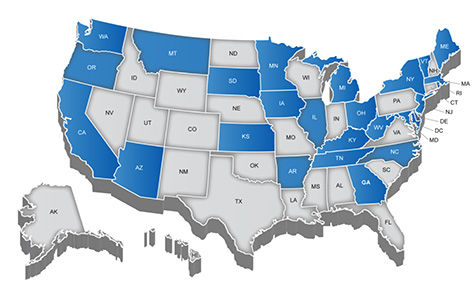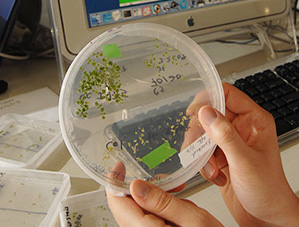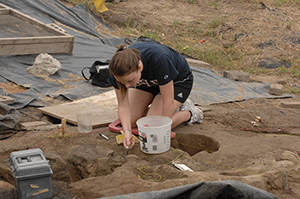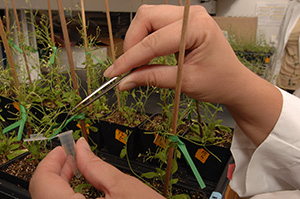
The United States currently does not have national K-12 science education standards, Wysession said. Each state determines its own standards, reflecting the tradition of independent states’ rights.
“This is the first push at moving us out of a parochial, local view of education,” said Wysession. “We’re saying, ‘You know what? There are things about the practice of science everyone should know, and this is what they are.’”
But it was equally important that the standards not be imposed on the states from the federal level, as was the now widely disparaged No Child Left Behind Act.
The Next Generation Science Standards were written by a states-led team organized by Achieve, a bipartisan nonprofit education group founded by leading governors and business leaders in 1996. Achieve also led the writing of the math and English language arts Common Core, released in 2010.
No tax dollars were spent on the standards. Instead, private foundations, including the Carnegie Corporation of New York, the Noyce Foundation and the Cisco Foundation, provided financing.
Achieve hoped to enlist half a dozen states to participate in the standards-writing process, but so many states volunteered to be partners that Achieve had to limit participation.
“It’s a real mix of red and blue states,” Wysession said of the state partners. That’s important because state legislatures must adopt the standards.
But industry is pushing state legislatures to adopt the standards, Wysession said. Industrial leaders realize that to be competitive, they must have access to a workforce that can solve problems requiring scientific and technical knowledge.
What are the odds the new standards will be adopted by the majority of states? It’s too early to say, but one good omen for supporters is that 45 states have adopted the Common Core — despite concerns that they increase federal control of schools.
Shorter but deeper

The new standards replace overviews with a series of in-depth explorations and require that students understand how science and scientists actually work rather than merely memorize information.
“Information used to be hard to come by,” Wysession explained. “My school years were spent bicycling across town to the library to write my reports. Kids now have a universe of information at their fingertips, and there’s no need for students to memorize factoids. In fact, there is too much information available.”
As Bruce Alberts, editor-in-chief of the journal Science, put it in an editorial titled “Failure of Skin-Deep Learning,” the traditional approach “tends to promote a superficial ‘comprehensive coverage’ of a field. . . . We need to replace the current ‘comprehensive’ overviews of subjects with a series of in-depth explorations.”
“We must teach our students to do something in science class, not memorize facts,” Alberts said in a second editorial.
Many teachers apparently agree. Writing in The New York Times blog for science teachers, one said, “Our system progressively smothers curiosity out of most kids by burdening them with dates, numbers, facts and equations that seem (to them) to have no relevance to their lives.”
Another teacher wrote, “Currently when I give them a test, they can provide canned answers to definitions, statements, etc. However, when they have to apply knowledge, they are mediocre.”
A third said, “ “Students must understand how we know what we think we know, how to think like a scientist, and how to engage in the scientific inquiry process. That type of learning is what’s embodied in [the new standards].”
Adding earth science and engineering

U.S. secondary school science curricula are largely based on recommendations made 120 years ago by a group called the Committee of Ten, said Wysession. The Committee of Ten suggested that “physical geography” be taught in middle school and that biology, physics and chemistry be taught in high school.
Things have changed since then, Wysession said. Many of the most important problems we face as a society involve earth systems, such as air pollution, water shortages and global warming. Yet roughly two-thirds of American students report not being taught about climate change, according to the National Center for Science Education.
In the new standards, at the high school level, the attention paid to earth and space sciences is roughly equal to that paid to chemistry and physics combined. In addition, the standards incorporate a new emphasis on engineering, technology and applications of science.
Wysession said the science standards include evolution and climate change as a matter of course. And, he said, “You can’t cherry-pick. You can’t leave out evolution or climate change and still say your curriculum adheres to the national science standards.”
It should be easy to motivate students to learn the earth sciences, he said, because they are directly relevant to students’ lives.
“Go through the front page of the The New York Times over a year and tally up science topics you see,” he said. “You’ll see earthquakes, oil spills, forest fires, tornadoes — all this stuff that’s in earth science. So I think people would love to teach it and students would love to learn about it.”
A college teacher, writing on the The New York Times blog, agrees: “The best way perhaps to teach climate change is to integrate it with teaching of chemistry and physics — because it brings a certain reality to these otherwise sometimes abstract subjects.”
One concern a few teachers voice is that climate science can be depressing. Students will be taught about the enormous impact of human activities on our planet, Wysession said, but the standards are also designed to teach them how to discover solutions to problems such as global warming.
A science curriculum specialist and middle-school science teacher takes a stronger view: “I believe there is a moral imperative to teach this generation of students about this topic since they are going to be the generation forced to face and, hopefully, solve the effects of climate change most directly.”
Assessment, professional development and money

The new standards are not curricula. They are intended instead to guide curriculum development. It may be years before the guidelines are fully translated into detailed curricula, teachers are trained and standardized assessments are adopted.
Wysession is acutely aware that most science assessments test memorized facts. New tests must be devised if students are to be assessed on what they can do instead of what they know. But, he said, there will be a report on how best to handle this challenge from the National Academy of Sciences in the next couple of months.
He also is aware that many teachers are unfamiliar with the fields of earth science and engineering, so adopting the standards will entail significant professional development.
One teacher raised this concern in The New York Times blog, “As a professor of pre-service teachers for the elementary grades, I am seeing a tremendous lack of content knowledge required to pass teacher licensing tests . . . It appears that the current crop of teachers are dreadfully unprepared to teach science in their classrooms.”
A science teacher and science director in the New York State public schools said that if you surveyed schools to see how many professional development days were devoted to science “your jaw would drop” and that funding for STEM (science, technology, engineering and math education) is a “blip on the radar” compared to funding for language arts.”
“Money will be important,” Wysession said. “A state can be all gung ho about adopting the standards, and then the economy tanks and they have no money for it.”
He has talked to groups of principals who told him pre-emptively that it would be difficult to make changes without new money.
Worries aside, however, it is apparent that most science teachers are enthusiastic about the Next Generation Science Standards and hopeful that they will go some distance to turning around the science illiteracy that long has plagued American students, giving them a better chance for success in college and in the international job market.